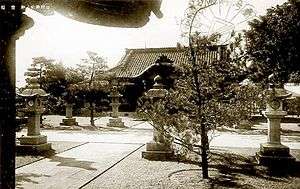Taiwan Grand Shrine

The Taiwan Grand Shrine (Japanese: 臺灣神宮 Hepburn: Taiwan jingū) was the highest ranking Japanese Shinto shrine in Taiwan during Japanese colonial rule. Among the 66 officially sanctioned Shinto shrines in Taiwan, Taiwan Grand Shrine was one of the most important and its elevation was also the highest of the shrines.
The Taiwan Grand Shrine was built as Taiwan Shrine in 1901 (Meiji 34) atop Jiantan Mountain (Chinese: 劍潭山) in the Jiantan area of Taihoku (modern-day Taipei). Prince Yoshihisa and the Three Kami Deities of Cultivation were added as enshrined deities (祭神 saijin). The Taiwan Grand Shrine was elevated in rank to Grand Shrine in 1944 (Shōwa 19) when the kami deity Amaterasu was enshrined. Taiwan Grand Shrine was the tutelary shrine of Taiwan and the most important Shinto shrine in Taiwan. The Governor-General of Taiwan designated October 28 as Taiwan Shrine Festival (臺灣神社祭 Taiwan jinjasai) and a public holiday throughout Taiwan.
On April 12, 1923 Crown Prince Hirohito, who would become Emperor Shōwa three years later, embarked on a two-week tour of Taiwan. In preparation for his visit to the Taiwan Grand Shrine, Chokushi Road (勅使街道 Chokushi kaidō) (present-day Chungshan North Road) was created leading to the shrine.
On October 23, 1944, prior to the Taiwan Shrine Festival, a passenger transport plane lost control and crashed atop the mountain where the Taiwan Grand Shrine was located. The accident and resulting fires destroyed the Torii ceremonial archway, stone tōrō lanterns, amongst other important structures.

After World War II, Taiwan Hotel was built on the original site of the Taiwan Grand Shrine. It was later expanded in 1952 to become the present-day Grand Hotel. Two copper bulls leading to the Taiwan Grand Shrine were relocated to National Taiwan Museum.